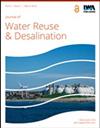Revealing the membrane fouling mechanism caused by the denitrification filter effluent during ozonation by model assessment
IF 2.3
Q2 Environmental Science
引用次数: 6
Abstract
Membrane fouling has been a major obstacle for stable operation of ultrafiltration. In this study, prevailing fouling models were applied to assess the fouling behavior of the denitrification filter (DNF) effluent during ozonation. In order to clarify the fouling mechanism, correlation analysis and redundancy analysis (RDA) were conducted to investigate the correlations among model parameters, fouling potential and water features of the DNF effluent. The combined intermediate-standard model exhibited superior determination coefficients (R2 > 0.99). Based on analytical results, the model parameter of intermediate blocking (Ki) and standard blocking (Ks) was fairly applicable to describe the fouling of higher molecular weight (F1, MW >4,000 Da) and lower molecular weight fractions (F2, MW = 2,000–4,000 Da and F3, MW < 2,000 Da), respectively. In comparison, F1 played a predominant role in the fouling behavior of the DNF effluent. Increased ozone dosage resulted in decreased membrane fouling contribution of F1 and increased fouling contribution of F2 and F3 during ozonation. The change of fouling contributions was attributed to the transformation of high MW fractions into lower MW fractions by ozonation. This study clarified the relationships between model parameters and the membrane fouling process caused by organic fractions with specific molecular weight, thus demonstrating the membrane fouling mechanism of the DNF effluent during ozonation.通过模型评价揭示了臭氧化过程中反硝化滤池出水引起膜污染的机理
膜污染一直是影响超滤稳定运行的主要障碍。在本研究中,应用流行的污染模型来评估臭氧化过程中反硝化过滤器(DNF)出水的污染行为。为了明确污染机理,采用相关分析和冗余分析(RDA)对模型参数、污染电位和DNF出水水质特征之间的相关性进行了研究。联合中间标准模型具有较好的决定系数(R2 > 0.99)。分析结果表明,中间堵塞(Ki)和标准堵塞(Ks)的模型参数分别适用于描述高分子量组分(F1, MW bb0 ~ 4000 Da)和低分子量组分(F2, MW = 2000 ~ 4000 Da和F3, MW < 2000 Da)的结垢。相比之下,F1在DNF出水的污染行为中起主导作用。臭氧用量增加导致臭氧化过程中F1对膜的污染贡献减小,而F2和F3对膜的污染贡献增大。污染贡献的变化归因于臭氧氧化将高分子量馏分转化为低分子量馏分。本研究阐明了模型参数与特定分子量有机组分引起的膜污染过程之间的关系,从而揭示了臭氧化过程中DNF出水的膜污染机理。
本文章由计算机程序翻译,如有差异,请以英文原文为准。
求助全文
约1分钟内获得全文
求助全文
来源期刊

Journal of Water Reuse and Desalination
ENGINEERING, ENVIRONMENTAL-WATER RESOURCES
CiteScore
4.30
自引率
0.00%
发文量
23
审稿时长
16 weeks
期刊介绍:
Journal of Water Reuse and Desalination publishes refereed review articles, theoretical and experimental research papers, new findings and issues of unplanned and planned reuse. The journal welcomes contributions from developing and developed countries.
 求助内容:
求助内容: 应助结果提醒方式:
应助结果提醒方式:


